Forum
PUSH(ed) to the Periphery:
The Intersection of Disability, Race, and Gender at the 2015 Parapan Am Games1
1 In conjunction with the 2015 Pan Am and Parapan Am Games, the host city of Toronto commissioned twenty-eight performing arts productions as a part of the cultural initiative called Panamania. Dozens of free concerts, events, and a festival-like atmosphere contributed to the Panamania project, which aimed to enhance the overall experience of the Pan Am/Parapan Am Games (“Panamania Arts & Culture Program” 1). Remarkably, however, out of the twenty-eight ticketed events, only three took place during the Parapan Am Games, suggesting an expectation bias (either explicit or implicit): specifically, that the Pan Am Games would draw more attendance than the Parapan Am event, and therefore boost Panamania sales in the earlier period.
2 The three Panamania productions commissioned for programming during the Parapan Am Games were Obeah Opera ~ A Nicole Brooks Vision; PUSH! Real Athletes. Real Stories. Real Theatre.; and MIX. Obeah Opera ~ A Nicole Brooks Vision (starring creator Nicole Brooks) was performed six times at the Young Centre for the Performing Arts. Demonstrating stunning endurance and musicality, the entire production is sung a cappella, and the only rhythmic accompaniment comes from the actors’ bare feet and hands. The theatre/music production depicts the lesser-known perspective of captured and enslaved African and Caribbean women who were persecuted during the Salem witch trials after their cultural and spiritual practices were misinterpreted by Puritans as witchcraft. PUSH! Real Athletes. Real Stories. Real Theatre. was written by Ping Chong and Sara Zatz in collaboration with six highly accomplished Para-athletes: Sarai Demers, Jenna Lambert, Victoria Nolan, Paul Rosen, Martha Sandoval Gustafson, and Jody Schloss. Produced by Tangled Art + Disability, PUSH! was staged for six performances at the Young Centre for the Performing Arts. PUSH! is a provocative departure from conventional theatre, as the six athletes are also the performers, telling their stories onstage themselves rather than having actors depict the narratives for them. MIX (choreographed by Deborah Colker) ran twice at the St. Lawrence Centre for the Arts. Performed by Brazil’s Companhia de Dança, MIX is an intensely athletic amalgamation of various styles of dance, from ballet to modern, and gymnastics, which culminated in a breathtaking dance on a climbing wall. The production’s connection to the athleticism of the Games is clear, but its connection to the Parapan Am Games is questionable, as the show features non-disabled dancers only.
3 Thus, of the twenty-eight commissioned Panamania productions, only two shows featured visibly disabled artists. Besides PUSH! a dance production called Limitless, which ran during the Pan Am Games, was performed and produced by the breakdance group ILL-Abilities (made up of dancers with various impairments). Incorporating Limitless into the Pan Am Games, rather than restricting disability arts productions to the Parapan Am Games, was a positive step toward the integration of disability arts into the mainstream. However, when we consider that twenty-six of the commissioned productions lacked disability representation, we are moved to question Panamania’s mandate to be a cultural experience “characterized by a spirit of innovation, diversity, and collaboration,” a promise made by Don Shipley, the Creative Director of Panamania, leading up to the Games (CBC.ca).
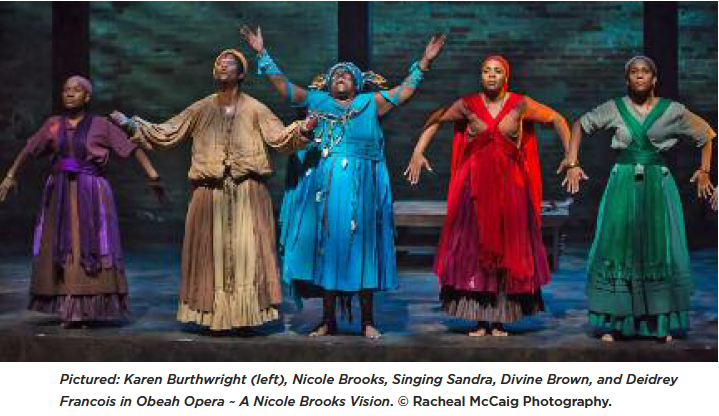 Display large image of Figure 1
Display large image of Figure 14 Obeah Opera ~ A Nicole Brooks Vision was staged by Nightwood Theatre, a production company that works to cultivate “creative alliances among women artists from diverse backgrounds” (“Mandate & Mission” 1). Why did this opera, a production featuring an all-female, racially diverse cast, debut during the Parapan Am Games? In this review, I will address whether it was problematic or productive to place a production with cast members who are socially marginalized by gender and race within the context of disability, and consider this question in relation to Mike Oliver’s “social model of disability.” Oliver’s foundational work in disability studies [D]oes not deny the problem of disability but locates it squarely within society. It is not individual limitations […] which are the cause of the problem but society’s failure to provide appropriate services and adequately ensure the needs of disabled people are fully taken into account in its social organisation. (Oliver 3)
5 In the context of this model, Kate Ellis and Gerard Goggin argue that “one [can] draw a strict line between impairments (as the bodily experience) and disability (as the social creation of unnecessary barriers, exclusion and discrimination). One might have a particular impairment, but be ‘disabled’ or ‘enabled’ by social arrangements” (78). If we consider disability as a social construct that causes social marginalization, then racism and its inherent social exclusion can arguably be included within the context of disability, giving logic to the inclusion of Obeah Opera with Panamania events concurrent with the Parapan Am Games. However, it was reported that half of the tickets for the Parapan Am Games went unsold (Lepofsky 2), which unfortunately confirmed the expectations of Panamania organizers: that the Pan Am Games would attract more sales for both sporting and cultural events. As David Lepofsky points out in a Toronto Star article: “[o]ne hundred thousand empty seats translates into 100,000 people whose attitudes on disability were not changed” (2). The meagre attendance rates at the Parapan Am Games evoke questions regarding accessibility, such as: what initiatives were made to include disabled patrons? Were tickets affordable?2 Were personal assistants accompanying disabled patrons charged for tickets, or were they comped? Moreover, how accessible were the sporting venues? Did the Games provide sufficient resources, such as wheelchair seating, closed captioning, audio-description, and transportation options? These same questions are pertinent to understanding attendance and accessibility in relation to the Panamania events that took place simultaneously with the Parapan Am Games.
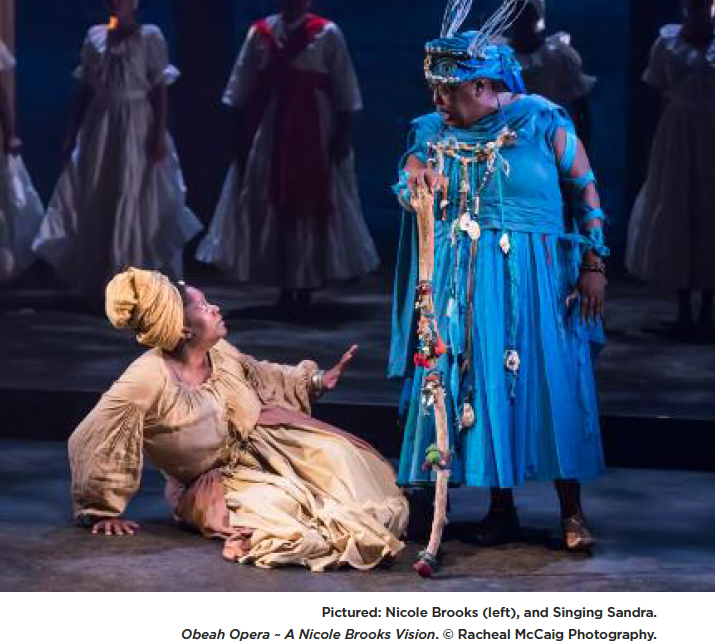 Display large image of Figure 2
Display large image of Figure 2Issues of Accessibility and Inclusivity at the Parapan Am Games
6 According to Nicole Brooks (creator, composer, librettist, and one of the lead actors in Obeah Opera) all six performances of Obeah Opera that ran during Panamania sold out. Further, Obeah Opera “was the only show in the Young Center/Baille Theatre during the Pan Am Games that sold out” (Brooks 1). It appears that Obeah Opera’s association with the Parapan Am Games, and subsequently the disability community, did not affect attendance rates, nor did the all-female, racially diverse cast. Obeah Opera’s success suggests that audiences are drawn to Canadian productions with diverse casts, which indicates the potential for a positive shift within the Canadian arts community toward productions that are more inclusive.
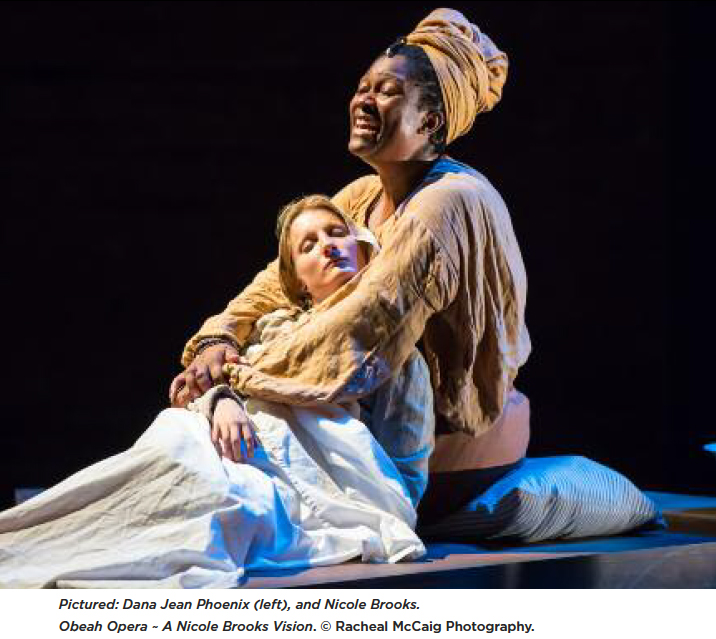 Display large image of Figure 3
Display large image of Figure 37 Obeah Opera is a hybrid of Afro-Caribbean song and dance performed by an all-female cast that is immensely talented and brave: because there is no music to contribute to the emotional labour the show requires, the affective success of the production relies entirely on the voices, faces, and bodies of the actors. At the August 8, 2015 matinee I attended, I saw the profound emotional impact that Brooks’s show had on the audience: people were crying, clapping, and singing along with the songs, and even calling out in response to the actors’ lines. I noticed that the majority of audience members at the matinee were persons of colour, which I think speaks to the production’s successful appeal to a diverse range of theatregoers who want to see their communities represented onstage. However, it is important to consider whether or not Obeah Opera was inclusive and accessible for the disabled community with which it became associated through its scheduling alongside the Parapan Am Games. In comparison to PUSH!, Obeah Opera did not appear to have the same level of accessibility. PUSH! featured a large area of wheelchair accessible seating, which did not require patrons to transfer out of their chairs, as well as an ASL interpreter, English print-captioning, and audio description. Further, accessible transportation to and from the Athletes’ Village was provided during PUSH! performances, but not during Obeah Opera. This suggests bias on behalf of Panamania organizers: the assumption that disabled athletes and theatregoers would be drawn to PUSH! as a production featuring disabled athletes, but not to Obeah Opera.
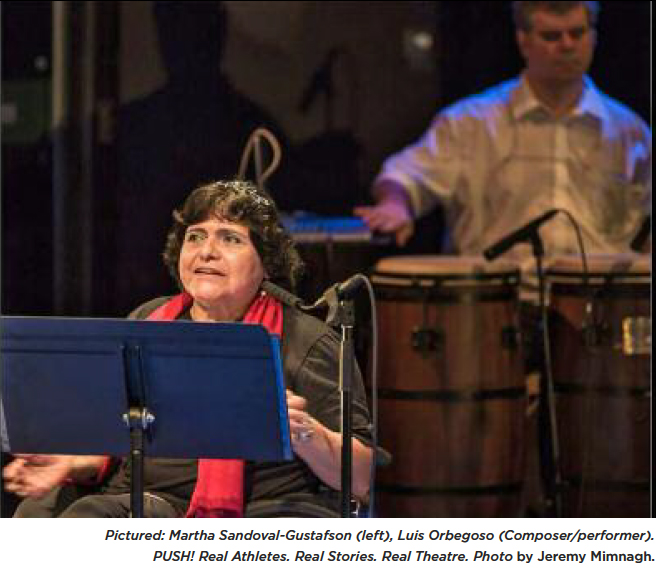 Display large image of Figure 4
Display large image of Figure 48 Katie McMillan, Director of Operations at Tangled Art + Disability, which produced PUSH!, offered a possible explanation in a phone interview. McMillan’s experience has been that there is still a general misperception that exists about disability arts: namely, that it is “art as therapy, as opposed to being of value to [the] general public. Many artists may consider their process therapeutic but the misconception with disability arts is that the process is the achievement and the art is not considered to be of value to general audiences the way that art by non-disabled artists is.” According to McMillan, PUSH! did not receive the same perceived credibility or attention that other Panamania shows obtained, which was reflected in audience demographics. For instance, McMillan observed that there was a lot of media coverage of PUSH! leading up to Panamania, but Tangled had a difficult time getting reviewers to attend the show. An online search supports McMillan’s claims: neither The Toronto Star nor The Globe and Mail appear to have reviewed PUSH! despite publishing feature articles in the weeks before Panamania. This surprised McMillan, considering not only producer Ping Chong’s worldwide reputation 3 but also the unique opportunity for audiences to hear the stories of six elite Para-athletes during the Parapan Am Games. McMillan’s observations echo Lepofsky’s article; the general public’s perception of disabilities has been slow to change, and unfortunately, the chance for a new perspective provided by the Parapan Am Games and PUSH! was not taken up by audiences on a large enough scale.
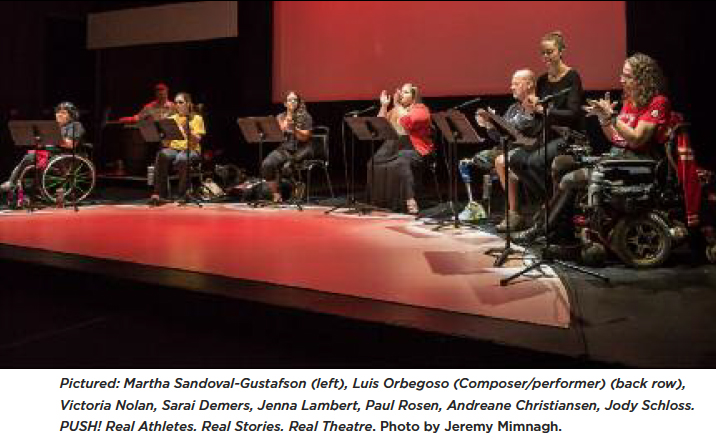 Display large image of Figure 5
Display large image of Figure 59 From where does the misperception of disability arts as therapy emerge? In “Effecting Change: Disability, Culture and Art”?, Colin Barnes argues that when the average person thinks of disability arts, they likely associate it with the art therapy done in “the context of special schools, day centres, and segregated institutions” (7). Moreover, Barnes claims that this thinking is “based on paternalism” (7) whether conscious or unconscious, which non-disabled individuals tend to assume toward the disabled community, extending into the arts. Barnes’s view is informed by the work of disability arts scholar and activist Allan Sutherland, who contends that associating disability arts with art therapy “assumes we have nothing to communicate. We, of course, know better, but as in so much else, we have had to reclaim our very right to existence” (2). Barnes explains that disability arts, rather than being art therapy, works to reveal “the role of the arts in developing cultural (and by inference political) identity” (8). Further, he draws on the work of Elspeth Morrison and Vic Finkelstein who posit:
Unfortunately, the political nature of disability arts seems to elude the general public, as well as even more seasoned theatregoers and reviewers, at least when it came to Panamania. While production companies like Tangled Art + Disability are working toward changing audiences’ minds about disability arts, they can only do so if the public and the media are willing to engage fully with their work.
10 PUSH! did not function as art therapy in performance. The show featured six very accomplished elite Para-athletes, and while their narratives did incorporate the everyday experience of disability, it was always in relation to the role that competitive sports played in each of their lives. These were not stories steeped in the histrionic, and they certainly did not resemble the emotional processing of a group therapy session. Rather, each athlete spoke candidly about the sacrifice and drive that it took to reach the levels that they did in sports, from the Paralympics to the Parapan Am Games. Further, each intersecting narrative incorporated the history of Para-athletics worldwide, while contextualizing the Parapan Am Games and its relationship to the greater history of increased civil rights and accessibility for disabled persons. Since 1992, Ping Chong + Company have been producing a series of works that are collectively called Undesirable Elements, which Chong’s company describes as “an ongoing series of community-specific interview-based theater works examining issues of culture and identity of individuals who are outsiders within their mainstream community” (“Undesirable Elements” 1). The process of selecting participants involves the following:
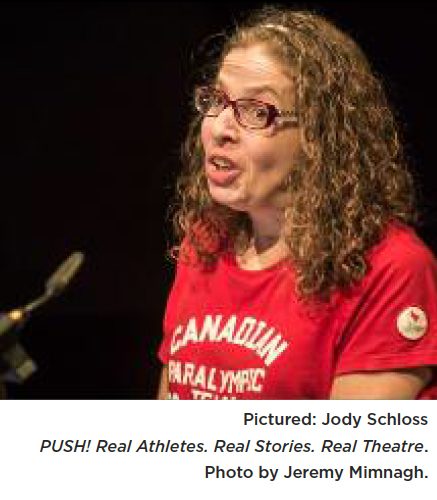 Display large image of Figure 6
Display large image of Figure 611 PUSH! evoked the universal and prevalent nature of disability, which made the production relatable and empathic, in my opinion. For example, at the conclusion of the show, the athletes state that one in seven people live with some sort of disability: that means one billion people worldwide. They also emphasize that this forms “the largest minority group in the world, and one that anyone can become a part of at any time” (Chong et al.). Perhaps it is the reminder that no one is removed from disability that causes audiences to pause before engaging with disability arts. Is it simply that many people have not changed their minds about disability, or are audiences resistant to shows like PUSH! because disability arts directly confronts non-disabled privilege and the systemic oppression of disabled communities? It can be an uncomfortable reality to face the quotidian aggressions and institutional violence (both physical and mental) that the non-disabled world explicitly and implicitly perpetuates against disabled persons. So how might the disability arts community go about attracting audiences, including reviewers, who will take their work seriously?
Moving Forward
12 Morrison and Finkelstein’s previously mentioned work explicates the task-at-hand nicely: “ensuring an integrated role for disability arts and culture” (12). What might this approach have looked like at Panamania? First, an equal balance of commissioned productions across the Pan Am and Parapan Am Games, rather than the ratio of twenty-five to three that unfolded. The paucity of cultural events associated with the Parapan Am Games in relation to the Pan Am Games conveys the message to audiences and athletes alike that Para-athletics are not as important or revered as non-disabled sporting events. Arguably, this reveals the systemic privileging of non-disabled over impaired or disabled individuals that social, economic, and political institutions have historically carried out, and continue to carry out today. This hierarchy of value attached to bodies likely explains (at least partially) the lack of media coverage or reviewer interest in PUSH! and the lukewarm interest in disability arts in general.
13 Further, McMillan identifies an important barrier in disability arts: getting influential reviewers to attend and write about shows. In our phone interview she emphasized the importance of media coverage and the presence of reputable reviewers in order to garner a certain amount of credibility in the eyes of the arts and culture scene and its patrons. The misconception of disability arts as art therapy needs to be dispelled, and one way to accomplish this is by allocating the same amount of media and critical attention to productions by disabled artists as to the rest of the arts and culture community. Patrons will subsequently fund and attend arts productions that are being taken seriously by respected journalists, reviewers, and scholars.
14 Finally, I wonder why collaboration between disabled and non-disabled artists did not occur onstage at Panamania. For example, the commissioned dance production MIX, which also took place during the Parapan Am Games, featured non-disabled dancers. This could have been an opportunity to integrate the “ILL-Abilities” dancers from Limitless who had performed earlier. Perhaps audiences implicitly assume that disability arts are aimed solely at disabled audiences if the productions feature only disabled artists. A way to challenge the marginalization of disability arts might be to foster working relationships between disabled and non-disabled performers, which could lead to integrated productions that are more attuned to accessibility and inclusivity. The collaboration that did occur between disabled and non-disabled artists was less visible to the general public, unfortunately, because it happened behind the scenes: the audience was not privy to the artistic cooperation that took place between Chong and Zatz, and among the athletes/performers Demers, Lambert, Nolan, Rosen, Sandoval Gustafson, and Schloss in order to create the script for Push!, for example.
15 The organizers of Panamania had the opportunity to showcase the unique diversity of the Canadian arts scene; unfortunately, they neglected to focus on the already overlooked disability arts community. I think that the popularity of productions like Obeah Opera reveal that audiences are malleable and open-minded when they are afforded the opportunity to be. The next task is for the government and private corporations, as the major providers of funding for the arts in Canada, to support disability arts at the same level. Obeah Opera’s six sold-out shows during Panamania demonstrate the very real potential to mobilize social and financial support for minority artists when audiences get on board; to achieve this, responsibility begins with attention from the presenters, media, scholars, and well-known reviewers.